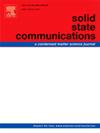掺杂剂层间距离、磁场和电场对双δ掺杂量子阱非线性光学整流、二次谐波和三次谐波产生的影响
IF 2.4
4区 物理与天体物理
Q3 PHYSICS, CONDENSED MATTER
引用次数: 0
摘要
研究了掺杂层间距变化对非线性整流系数(NOR)、二次谐波产生系数(SHG)和三次谐波产生系数(THG)等关键光学特性的影响。采用对称的双v型电位模型,外加电场破坏了对称性,提高了二阶磁化率。在此背景下,分析了电场和磁场对这些非线性光学性质的综合影响。本文研究了由n型GaAs组成的双δ掺杂量子阱结构(DDDQW),其两层掺杂密度相同。采用有限差分法,采用Thomas-Fermi、有效质量和抛物线带近似推导了系统的电子结构。我们的研究结果表明,改变掺杂层之间的距离和改变外部电场和磁场会改变NOR、SHG和THG系数最大峰的位置和大小。这些发现对光电子工业具有重要意义,有助于设计和开发能够在太赫兹域特定频率范围内进行先进光操作和检测的材料和设备。本文章由计算机程序翻译,如有差异,请以英文原文为准。
Effects of dopant interlayer distance, magnetic field and electric field on nonlinear optical rectification, second and third harmonic generation in double δ-doped quantum wells
The influence of the variation in separation between the doped layers on key optical properties, such as the nonlinear rectification coefficient (NOR), the second harmonic generation coefficient (SHG), and the third harmonic generation coefficient (THG), has been investigated. A symmetric double V-shaped potential model was utilized, where an external electric field was applied to break the symmetry and enhance the second-order susceptibility. In this context, the analysis of the combined effects of both electric and magnetic fields on these nonlinear optical properties is included. This study focuses on a double delta-doped quantum well structure (DDDQW), composed of -type GaAs, with identical doping densities in both dopant layers. The electronic structure of the system was derived using the finite-difference method employing the Thomas–Fermi, effective mass, and parabolic band approximations. Our results reveal that altering the distance between dopant layers and varying the external electric and magnetic fields modifies both the position and magnitude of the maximum peaks of the NOR, SHG, and THG coefficients. These findings have implications for the optoelectronics industry, contributing to the design and development of materials and devices capable of advanced light manipulation and detection within specific frequency ranges in the terahertz domain.
求助全文
通过发布文献求助,成功后即可免费获取论文全文。
去求助
来源期刊

Solid State Communications
物理-物理:凝聚态物理
CiteScore
3.40
自引率
4.80%
发文量
287
审稿时长
51 days
期刊介绍:
Solid State Communications is an international medium for the publication of short communications and original research articles on significant developments in condensed matter science, giving scientists immediate access to important, recently completed work. The journal publishes original experimental and theoretical research on the physical and chemical properties of solids and other condensed systems and also on their preparation. The submission of manuscripts reporting research on the basic physics of materials science and devices, as well as of state-of-the-art microstructures and nanostructures, is encouraged.
A coherent quantitative treatment emphasizing new physics is expected rather than a simple accumulation of experimental data. Consistent with these aims, the short communications should be kept concise and short, usually not longer than six printed pages. The number of figures and tables should also be kept to a minimum. Solid State Communications now also welcomes original research articles without length restrictions.
The Fast-Track section of Solid State Communications is the venue for very rapid publication of short communications on significant developments in condensed matter science. The goal is to offer the broad condensed matter community quick and immediate access to publish recently completed papers in research areas that are rapidly evolving and in which there are developments with great potential impact.
 求助内容:
求助内容: 应助结果提醒方式:
应助结果提醒方式:


